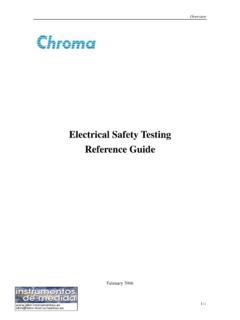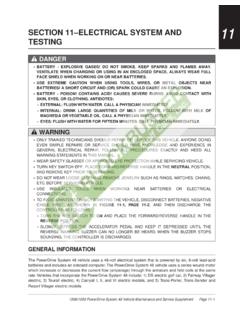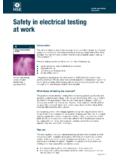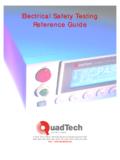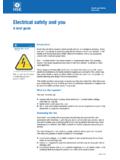Transcription of U.S. Department of Labor Occupational Safety and Health ...
1 Department of Labor Occupational Safety and Health Administration OSHA 3075. 2002 (Revised). Department of Labor Elaine L. Chao, Secretary Occupational Safety and Health Administration John L. Henshaw, Assistant Secretary OSHA 3075. 2002 (Revised). This booklet provides a generic overview of a standards-related topic. This publication does not alter or determine compliance responsibilities, which are described in the OSHA standards and the Occupational Safety and Health Act. Because interpretations and enforcement policy may change over time, the best sources for additional guidance on OSHA compliance requirements are current administrative interpretations and decisions by the Occupational Safety and Health Review Commission and the courts. This publication is in the public domain and may be reproduced fully or partially without permission.
2 Source credit is requested but not required. OSHA will make this information available to sensory impaired individuals upon request. Call (202) 693 1999. The teletypewriter (TTY) number is (877) 889 5627. To report an emergency, file a complaint, or seek OSHA. advice, assistance, or products, call (800) 321-OSHA. or contact your nearest OSHA regional or area office. The teletypewriter (TTY) number is (877) 889-5627. Contents Introduction .. 1. Why should you be concerned about electrical hazards? .. 2. What OSHA standards address electrical Safety ? .. 3. How do OSHA's standards minimize electrical hazards? .. 4. Electricity: The Basics .. 5. What affects the flow of electricity? .. 5. How does water affect the flow of electricity? .. 5. What causes shocks? .. 5. What effect do shocks have on the body?
3 6. What kind of burns can a shock cause? .. 8. Why do people sometimes freeze when they are shocked? .. 8. What should you do if someone freezes . to a live electrical contact? .. 9. How can you tell if a shock is serious? .. 9. What is the danger of static electricity? .. 10. Protection Against electrical Hazards .. 11. What is the best way to protect yourself against electrical hazards? .. 11. What protection does insulation provide? .. 11. How do you identify different types of insulation? .. 11. What is guarding and what protection does it offer? .. 12. What is grounding and what protection does it offer? .. 13. i What are circuit protection devices and how do they work? .. 14. What work practices help protect you against electrical hazards? .. 15. How can you protect yourself against metal parts that become energized?
4 15. How can you prevent an accidental or unexpected equipment startup? .. 16. How can you protect yourself from overhead power lines? .. 17. What protection does personal equipment offer? .. 18. What role do tools play? .. 18. What special training do employees need? .. 18. What's the value of a Safety and Health program in controlling electrical hazards? .. 19. How Can OSHA Help Me? .. 20. How does Safety and Health program management assistance help employers and employees? .. 20. What are state plans? .. 21. How can consultation assistance help employers? .. 21. Who can get consultation assistance and what does it cost? .. 22. Can OSHA assure privacy to an employer who asks for consultation assistance? .. 22. Can an employer be cited for violations after receiving consultation assistance?
5 22. Does OSHA provide any incentives for seeking consultation assistance? .. 23. What is the Voluntary Protection Program? .. 23. ii How does the Voluntary Protection Program work? .. 24. How does VPP help employers and employees? .. 24. How does OSHA monitor VPP sites? .. 25. Can OSHA inspect an employer who is participating in the VPP? .. 25. How can a partnership with OSHA improve worker Safety and Health ? .. 25. What is OSHA's Strategic Partnership Program (OSPP)? .. 26. What do OSPPs do? .. 26. Are there different kinds of OSPPs? .. 26. What are the benefits of participation in the OSPP? .. 27. Does OSHA have Occupational Safety and Health training for employers and employees? .. 28. Does OSHA give money to organizations for training and education? .. 29. Does OSHA have other assistance materials available?
6 30. What do I do in case of an emergency? Or if I need to file a complaint? .. 30. OSHA Offices .. 31. Regional Offices .. 31. Area Offices .. 33. State and Territories with OSHA-Approved Safety and Health Plans .. 48. OSHA Onsite Consultation Offices .. 54. iii Introduction T his booklet provides an overview of basic electrical Safety on the job. Electricity is essential to modern life, both at home and on the job. Some employees engineers, electricians, electronic technicians, and power line workers, among them work with electricity directly. Others, such as office workers and sales people, work with it indirectly. Perhaps because it has become such a familiar part of our daily life, many of us don't give much thought to how much our work depends on a reliable source of electricity.
7 More importantly, we tend to overlook the hazards electricity poses and fail to treat it with the respect it deserves. 1. Why should you be concerned about electrical hazards? Electricity has long been recognized as a serious workplace hazard, exposing employees to electric shock, electrocution, burns, fires, and explosions. In 1999, for example, 278 workers died from electrocutions at work, accounting for almost 5 percent of all on-the-job fatalities that year, according to the Bureau of Labor Statistics. What makes these statistics more tragic is that most of these fatalities could have been easily avoided. 2. What OSHA standards address electrical Safety ? OSHA standards cover many electrical hazards in many different industries. OSHA's general industry electrical Safety standards are published in Title 29 Code of Federal Regulations (CFR), Part through.
8 Design Safety Standards for electrical Systems, and through electrical Safety -Related Work Practices Standards. OSHA's electrical standards are based on the National Fire Protection Association Standards NFPA 70, National Electric Code, and NFPA 70E, electrical Safety Requirements for Employee Workplaces. OSHA also has electrical Safety standards for the construction industry, in 29 CFR 1926, Subpart K. OSHA's standards for marine terminals, in 29 CFR 1917, and for longshoring, in 29 CFR 1918, reference the general industry electrical standards in Subpart S of Part 1910. The shipyard standards, in 29 CFR 1915, cover limited electrical Safety work practices in 29 CFR Although OSHA operates a federal Occupational Safety and Health program, 24 states and 2 territories operate their own OSHA-approved programs.
9 In those states, the standards and other procedures governing electrical Safety may not be identical to the federal requirements. They must, however, be at least as effective as the federal standards. 3. How do OSHA's standards minimize electrical hazards? OSHA standards focus on the design and use of electrical equipment and systems. The standards cover only the exposed or operating elements of an electrical installation such as lighting, equipment, motors, machines, appliances, switches, controls, and enclosures, requiring that they be constructed and installed to minimize workplace electrical dangers. Also, the standards require that certain approved testing organizations test and certify electrical equipment before use in the workplace to ensure it is safe. 4. Electricity: The Basics What affects the flow of electricity?
10 Electricity flows more easily through some materials than others. Some substances such as metals generally offer very little resistance to the flow of electric current and are called conductors. A common but perhaps overlooked conductor is the surface or subsurface of the earth. Glass, plastic, porcelain, clay, pottery, dry wood, and similar substances generally slow or stop the flow of electricity. They are called insulators. Even air, normally an insulator, can become a conductor, as occurs during an arc or lightning stroke. How does water affect the flow of electricity? Pure water is a poor conductor. But small amounts of impurities in water like salt, acid, solvents, or other materials can turn water itself and substances that generally act as insulators into conductors or better conductors.











